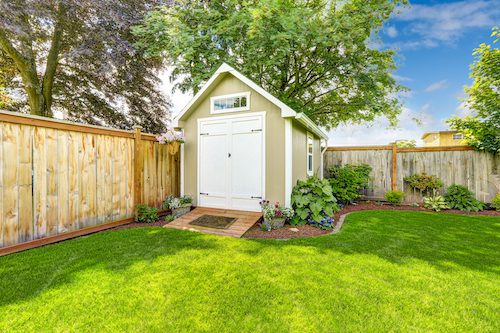A portable shed is a handy way to add storage to your home, especially for outdoor tools, equipment, and other long-term storage. However, these do-it-yourself (DIY) installations can be prone to sinking and settling, especially if not built on a sturdy foundation.
If you have a shed that is beginning to sink, or if you notice the doors are no longer sitting level and closing properly, you may be thinking about leveling it yourself with concrete blocks or wood shims. If you’re prone to taking the DIY approach, read on to learn everything you need to know about how to level a shed with concrete blocks (and whether or not this option will work for your shed):
Considerations Before Leveling a Shed with Concrete Blocks
On the surface, leveling your shed with a quick and affordable DIY fix may seem like a great option. Cinder blocks are very straightforward to install, and all you need is a floor jack and a level to have a nice, level shed in minutes flat!
However, there are many drawbacks to using this method of shed leveling that you should take into account before deciding how to fix your sinking shed:
Concrete Blocks Are Only Good for Small Sheds
Concrete blocks will not support your shed if it is larger than 160 square feet. You also should opt for a stronger foundation if your shed has multiple stories!
Concrete Blocks Have a Weight Limit
Sheds are often used to store heavy tools and equipment, which can be a lot of weight for the foundation to bear. Concrete blocks may lift your shed back to level, but they can’t fortify and support all the weight. If you use your shed to store something heavy, like a riding mower, it will eventually sag or collapse under the weight.
It’s Not a Long-term Solution
If you use concrete blocks to solve foundation sinking, keep in mind that this is a band-aid solution. Concrete blocks don’t support foundations below the frost line, which means that temperature and moisture fluctuations will eventually lead to settling yet again. In more serious settling situations, your shed floor could become unstable.
It Creates Gaps for Burrows
Because the concrete blocks don’t fill voids, your shed will have plenty of space underneath it for animals to crawl into and make themselves at home. This could also eventually draw these critters up into your shed, damaging anything in storage.
How to Level a Shed with Concrete Blocks
If you prefer a DIY approach or just need a temporary solution until you’re ready to invest more in the stability and safety of your shed, here is how to level a shed with concrete blocks, step by step:
Supplies Needed:
- 2-foot level
- 1.5-ton floor jack
- Concrete patio blocks (treated wood blocks or wood shims may also work)
How to Level a Shed
Start by identifying the area that must be raised to level your shed. This will either be the front of the shed, the back of the shed, or the door. Here is how to level a shed with concrete blocks when the front or back has settled:
- Install a floor jack under the front or back wall plate, depending on where the sinking has occurred.
- Position the level at the location of the settlement.
- Raise the shed until the bubble on your level is perfectly centered.
- Place a concrete block (or however many are needed) under the skid, filling the open space.
- Lower the jack and check again to make sure it’s now level.
Raising a Single Door Shed
If your shed has a single door that isn’t hanging correctly, level this part of the shed by raising the opposite back corner until it is level with the door. You will follow the same steps listed above, except install the floor jack under the opposing corner instead of centered on the back wall plate.
Raising a Double Door Shed
If your double-door shed has a gap at the top of the door, position the jack under the doors, insert a concrete block, and lower the jack to set your shed on top of the block. Check your doors to make sure they are aligned.
Level Your Shed for the Long Haul
If you want to level your shed in a manner that will last and guarantee safety and stability, the best way to go is professional concrete leveling. At Pro Polyjacking, we use a specially formulated polyurethane foam that is injected beneath concrete foundations at the site of settlement, flowing into all the gaps and voids and filling them before expanding and lifting your shed back up to level.
Polyjacking is the shed leveling option that resolves all the drawbacks of DIY approaches. It’s a long-term solution that works for sheds of any size, you don’t have to worry about a weight limit, and no animals can burrow through the eco-friendly materials!
If you’re having trouble getting your shed back on solid ground, contact Pro Polyjacking to experience the power of permanent concrete leveling solutions!
